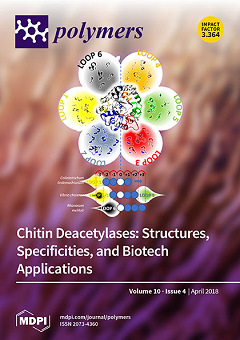In this study, methyltrimethoxysilane (MTMOS) was used as a reagent to prepare SiO
2-based wood-inorganic composites (WIC
SiO2) via the sol-gel process, and subsequently, the extended creep behaviors of WIC
SiO2 with weight percent gains (WPGs) of 10%, 20%,
[...] Read more.
In this study, methyltrimethoxysilane (MTMOS) was used as a reagent to prepare SiO
2-based wood-inorganic composites (WIC
SiO2) via the sol-gel process, and subsequently, the extended creep behaviors of WIC
SiO2 with weight percent gains (WPGs) of 10%, 20%, and 30% were estimated using the stepped isostress method (SSM). The results revealed that the density of all samples ranged from 426 to 513 kg/m
3, and no significant difference in the modulus of elasticity (MOE) was noted among all of the samples (10.5–10.7 GPa). However, the MOR of WIC
SiO2 with a WPG of 20% (102 MPa) was significantly greater than that of untreated wood (87 MPa). In addition, according to the result using the SSM, the SSM-predicted creep master curve fitted well with the experimental data for the untreated wood and WIC
SiO2. This result demonstrated that the SSM could be a useful method to evaluate long-term creep behaviors of wood and WIC
SiO2. Furthermore, the activation volume (
V*) of the specimens was calculated from the linear slope of Eyring plots, and the resulting
V* of all of the WIC
SiO2 (0.754–0.842 nm
3) was lower than that of untreated wood (0.856 nm
3). On the other hand, the modulus reduction of untreated wood showed 39%, 45%, 48%, and 51% at 5, 15, 30, and 50 years, respectively. In contrast, the modulus reduction of the WIC
SiO2 with a WPG of 10% decreased to 25%, 31%, 35%, and 38% at 5, 15, 30, and 50 years, respectively. Similar trends were also observed for other WIC
SiO2 with different WPGs. Of these, the WIC
SiO2 with a WPG of 20% exhibited the lowest reduction in time-dependent modulus (31%) over a 50-year period. Accordingly, the creep resistance of the wood could be effectively enhanced under the MTMOS treatment.
Full article






